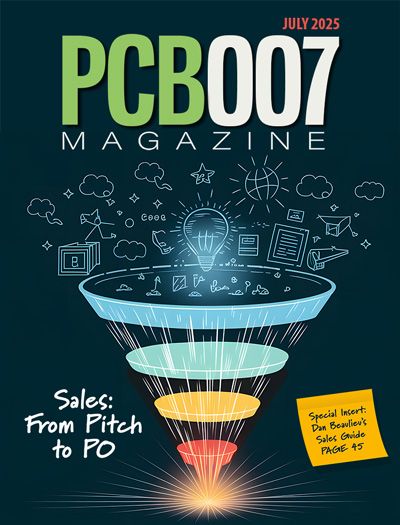-

- News
- Books
Featured Books
- pcb007 Magazine
Latest Issues
Current Issue
Advancing the Advanced Materials Discussion
Moore’s Law is no more, and the advanced material solutions to grapple with this reality are surprising, stunning, and perhaps a bit daunting. Buckle up for a dive into advanced materials and a glimpse into the next chapters of electronics manufacturing.

Inventing the Future With SEL
Two years after launching its state-of-the-art PCB facility, SEL shares lessons in vision, execution, and innovation, plus insights from industry icons and technology leaders shaping the future of PCB fabrication.

Sales: From Pitch to PO
From the first cold call to finally receiving that first purchase order, the July PCB007 Magazine breaks down some critical parts of the sales stack. To up your sales game, read on!
- Articles
- Columns
- Links
- Media kit
||| MENU - pcb007 Magazine
AI Demand Stands Out While Consumer Electronics Face Tariff Headwinds; 2H25 MLCC Peak Season at Risk
July 30, 2025 | TrendForceEstimated reading time: 2 minutes
The U.S. government plans to impose steep retaliatory tariffs starting August 1st, including up to 30% on imports from Mexico, 15% on the EU, and 15–36% on key tech hubs in Asia such as Japan, South Korea, Thailand, and Malaysia. With U.S. consumer spending growth revised down to just 0.5% in Q1—the lowest since the pandemic—TrendForce notes that the effects of front-loaded demand and stockpiling ahead of tariffs are fading. This casts uncertainty over the traditional back-to-school peak season in Q3, with MLCC order momentum clouded as a result.
TrendForce projects that the second half of 2025 is expected to see a clear split in demand. Orders for mid- to low-end consumer electronics like smartphones, notebooks, and tablets are projected to remain flat or grow just around 5% in Q3, as ODMs take a more conservative approach and avoid traditional peak-season strategies. Many vendors also rushed shipments in 1H25 to avoid tariffs, effectively cannibalizing demand from the latter half of the year.
In contrast, AI server demand remains red-hot. Major ODMs like Foxconn, Quanta, and Wistron saw a boost in May and June revenues with NVIDIA’s GB200 and GB300 platforms both ramping up shipments in Q3. MLCC stocking demand has jumped nearly 25% QoQ, especially for mid- and high-end consumer-grade MLCCs, benefiting suppliers such as Murata, Samsung, and Taiyo Yuden.
Polarization in utilization rates makes capacity and inventory management critical
The disparity in market demand has led to significant differences in MLCC supplier utilization rates. TrendForce’s July survey shows that Japanese and Korean suppliers focusing on high-end AI applications are operating at around 90% capacity. Chinese suppliers are at approximately 75%, while Taiwanese firms have dropped to around 60%. This reflects widespread caution within the supply chain, with strict control over both capacity and inventory in response to market uncertainties.
Amid mounting tariff pressure, MLCC suppliers are accelerating the setup of backend testing and packaging lines in Southeast Asia to enable localized production and mitigate the risk of punitive U.S. tariffs targeting origin mislabeling. TrendForce expects that under sweeping retaliatory tariffs, OEMs will be forced to restructure bids and spread the tariff burden across the supply chain, including materials providers, ODMs, logistics firms, advertising partners, and distributors.
Ultimately, this could result in higher end-product prices. As OEMs begin releasing 2026 RFQs for smartphones and notebooks in the second half of the year, the entire supply chain is bracing for intense tariff-related cost pressure and further margin compression.
Testimonial
"Advertising in PCB007 Magazine has been a great way to showcase our bare board testers to the right audience. The I-Connect007 team makes the process smooth and professional. We’re proud to be featured in such a trusted publication."
Klaus Koziol - atgSuggested Items
Nolan’s Notes: Tariffs, Technologies, and Optimization
10/01/2025 | Nolan Johnson -- Column: Nolan's NotesLast month, SMT007 Magazine spotlighted India, and boy, did we pick a good time to do so. Tariff and trade news involving India was breaking like a storm surge. The U.S. tariffs shifted India from one of the most favorable trade agreements to the least favorable. Electronics continue to be exempt for the time being, but lest you think that we’re free and clear because we manufacture electronics, steel and aluminum are specifically called out at the 50% tariff levels.
SIA Statement on Semiconductor Tariffs Announcement
08/27/2025 | SIAThe Semiconductor Industry Association (SIA) released the following statement from SIA President and CEO John Neuffer regarding President Trump’s semiconductor tariff announcement.
The Government Circuit: Navigating New Trade Headwinds and New Partnerships
08/25/2025 | Chris Mitchell -- Column: The Government CircuitAs global trade winds continue to howl, the electronics manufacturing industry finds itself at a critical juncture. After months of warnings, the U.S. Government has implemented a broad array of tariff increases, with fresh duties hitting copper-based products, semiconductors, and imports from many nations. On the positive side, tentative trade agreements with Europe, China, Japan, and other nations are providing at least some clarity and counterbalance.
50% Copper Tariffs, 100% Chip Uncertainty, and a Truce
08/19/2025 | Andy Shaughnessy, I-Connect007If you’re like me, tariffs were not on your radar screen until a few months ago, but now political rhetoric has turned to presidential action. Tariffs are front-page news with major developments coming directly from the Oval Office. These are not typical times. President Donald Trump campaigned on tariff reform, and he’s now busy revamping America’s tariff policy.
Product Refreshes and Inventory Pull-In Ahead of Tariffs Led to Growth in Tablet Market by 13.1% in Q2
08/08/2025 | IDCWorldwide tablet shipments grew 13.1% year-over-year in the second quarter of 2025 (2Q25), totaling 38.3 million units, according to data from the International Data Corporation (IDC) Worldwide Quarterly Personal Computing Device Tracker.


